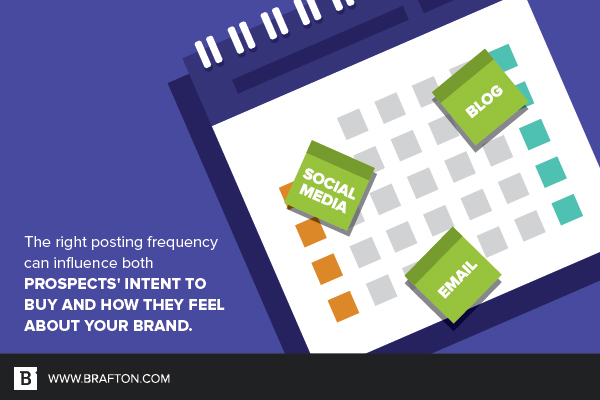You spend a lot of time crafting the perfect piece of content, but if you’re distributing it properly, you might not find success. After all, what’s the point of creating great content that doesn’t have an equally effective distribution strategy behind it?
Why frequency is important
To begin, let’s answer a pressing question: Why is perfecting your frequency so crucial?
Well, if you’re bombarding your audience with too much content, you’re going to start annoying your prospects and customers. That will turn them off from your brand, causing them to hit the “Unsubscribe” or “Unfollow” button – you lose business.
On the other hand, if you’re not posting enough content on a regular cadence, you leave your target audience wanting more, and chances are they’ll go elsewhere to find what they’re looking for – you lose business.
But blog, social and email content posting frequency also has an impact on decision-making and purchase intent. By finding the “sweet spot” for your industry, target audience and overall objectives, you can influence the purchasing intent of potential customers by delivering the right content at the right time.
If we’ve piqued your interest so far, check out our tips below on when you should post your content, and which channels to share it on, to bring in the results you’re looking for.

Your website
Finding the right balance for posting blogs, videos and other content marketing assets to your website depends on your industry, your prospect personas and your overall campaign strategy. How often does your business need to contribute to current conversations? At what frequency do you have something valuable and insightful to say? Do your prospects seek out content on your site every day, or are you more of a weekly pit stop in your potential clients’ work week?
Similarly, your content marketing goals might change. If you’re about to launch a series of products over the next six months, you should consider ramping up your content production as a result.
Social media
When it comes to social media, the different networks give you a bit more leeway in terms of your posting frequency. But be careful not to burn out your followers, or they’ll quickly turn away from your brand.
There is no uniform approach to social media posts in that each platform appeals to certain prospects who all have different preferences. It’s up to you to determine which social sites you want to target to expand your reach, and then identify the ideal posting cadence in suite. But it’s good to start somewhere, so here are some tips from Brafton’s social team for the major networks:
- Twitter: Post at least three times per day, but only share one to two pieces of your own content in addition to retweeting and sharing other relevant content with your followers.
- Facebook and LinkedIn: Similarly to Twitter, it depends on what content you’re sharing. If it’s all your own blog posts, eBooks, whitepapers, etc., then once or twice per day at a maximum. But you can consider posting more if you’re sharing other relevant content with your followers.
- Instagram: The frequency here really depends on what kinds of photos and images you’re sharing and whether you’re B2B or B2C. But it’s a safe bet to stick with one to two posts per day.
But there is one caveat to keep in mind, according to Brafton Social Media Strategist Walton Clark.
“Only post to the level of content that you have,” he explains. “If you only have two blogs per month, then adjust your social media strategy to reflect that.”
If you’re looking for more guidance on the best times to post on social, check out our gifographic!

When it comes to bringing in new customers, email is 40 times more effective than social media.
But blasting out emails to your prospects too frequently is just bothersome, not to mention that your messages lose their value, and both of these issues lead your recipients to unsubscribe. Conversely, communicating too infrequently runs the risk of missing opportunities to connect with your audience and convert them to customers.
Of course, discovering the right balance for sending emails can fluctuate depending on your target audience, any campaigns you’ve created and a variety of other factors. Sending one email every two weeks is the sweet spot. This ensures you’re getting your company in front of your potential customers without bombarding them with too much content.
These posting frequency best guidelines are a jumping-off point that you can use to develop a well-defined and thought-out content strategy. Changes will happen depending on a variety of factors, so as long as you are analyzing your results and making adjustments as you move forward to fit your needs, you’ll be headed in the right direction for managing a stellar content game plan.





